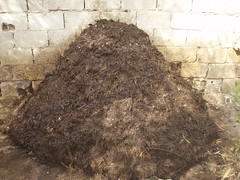15 days and still going strong. The shape of this pile is just about ideal. When we turn a pile we try and build the new pile it a nice uniform conical shape. In our experience this shape seems to get the best results. It has also been shown that this shape allows for better oxygenation of the pile. We have found that a lower rounder shape produces more heat and is more likely to turn anaerobic.
Like all aspects of assembling and producing compost achieving an nice shape takes practice, luckily one gets to practice on every turn. We are meticulous about every aspect of making compost. Some days it can take more than 30 mins to turn the pile because we are being very careful to mix and aerate the with each pitch fork and trying to build a nice shape.
Q an A
Some question sent to us via e-mail.
How long can something compost for and produce heat days, weeks or forever if you kept feeding it?
Our pile is still producing a lot of heat. We try to keep the temperate low by turning it every day. If it gets too hot many of the beneficial microbes will be killed off. We expect that it will be starting to cool off in the next few days. It is possible to keep a producing heat by adding more material. Brush turkeys in Australia us a compost heap as a nest. The male bird maintains a constant 30 degree temperature by adding an removing material through the whole incubation period.
Does the composting produce harmful gases?
Most of the gas that is produced by a compost pile is CO2. The C:N of the pile at the start should be about 30:1 by the end of the process it will be something like 10:1. the reduction in C is gassed off as CO2. It is also possible for a pile that has too much N that ammonia be gassed off the pile. We have also noticed a rotten egg smell around composts that are anaerobic, this is likely from a sulphur gas of some kind.
The smells from a compost are excellent patterns to use when working with your pile. One can learn a lot by smelling the pile. If a problem is noticed early enough a pile can be pushed in the right direction.
In order to experience these patterns you have got to turn your pile!!!!
Will run-away climate change make drought permanent?
18 years ago





No comments:
Post a Comment